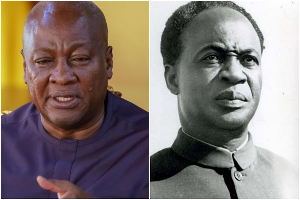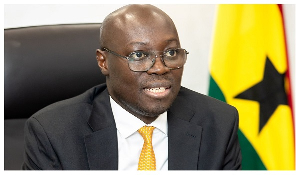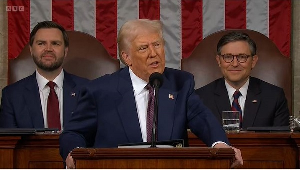*Jermaine Nkrumah*
There has been much talk in recent times about building a new international airport in the Ningo/Prampram area in Greater Accra to ease traffic at Kotoka International Airport also in Accra. Before we rush into agreements that can potentially lead to another round of judgment debts, let us have a national debate about the best location for a second international airport in Ghana. There cannot be a completely scientific analysis of where to place a second international airport if the arrived conclusion was to locate it in Accra where Kotoka is also located, has served us well for five decades, and can continue to serve us for another five decades. Here is how:
In terms of traffic, Kotoka is averaging less than 70 arrivals and 70 departures daily. These numbers would have to climb to better than 228 each for traffic to be too heavy for that airport. Why 228? Kotoka has a single runway (21) so wake turbulence becomes very important. Even that, given that light to medium aircraft operating there outnumber heavy aircraft by almost two to one, a minimum prescribed separation between landings and between takeoffs should be no longer than two and one half minutes. That means if the airport manages landings and takeoffs from 5am to midnight (1,140 minutes) 228 aircraft would have to land and take off in normal weather conditions for Kotoka to become too busy. Of course bad weather could reduce that number.
The length of Kotoka’s runway is currently listed at 2,987 meters – just 13 meters short of accommodating A380, the largest commercial aircraft in operation today. We know B747’s land and take off without any problems. Thus if we are worried about accommodating an A380, which requires roughly 3,000 meters to land or take off fully loaded, we could make use of the extra 150 meters of expansion available at the El-Wak end of the runway. Granted, we would have to make some adjustments to accommodate the A380’s 80 meter wing span.
[image: http://74.54.19.227/GHP/img/pics/40133771.jpg]Terminal facilities are a different animal although there are lateral expansion opportunities. Even that the perceived congestion is really self-inflicted. Ghana civil Aviation can lean on international carriers to adjust their schedule to avoid the near stampede that occurs only at nights. If just three on the international carriers that arrive in the evenings adjust their schedules to arrive some three to four hours earlier, rush hour at Kotoka may not be much to alarm proponents of a second Accra International Airport.
Another factor creating the impression that aircraft have difficulty maneuvering the parking area is that with the absence of aircraft tugs, the jumbos are parking to disembark and embark passengers such that they can turn around to taxi away. If we had tugs, they could come in perpendicular to the terminal building so that they can be tugged directly backwards to the area where their turns would not interfere with other parked aircraft.
So now you may ask that if Kotoka is not that busy, why do we need another airport in Kumasi? There is a variety of reasons including decentralization, landing options in the event of a mishap on Kotoka’s runway, and accessibility to majority of Ghanaians, among others.
For starters an estimated 70% of Ghanaians live closer to Kumasi than to Accra. It is inconsiderate to compel 70% of Ghanaians to travel long distances on mostly difficult roads to Accra in order to fly to international destinations. Travelers from Bawku (Upper East), Bogoso (Western), Berekum (Brong Ahafo), and even Kete Krachi (Volta) can get to Kumasi faster and easier than they can get to Accra. Placing a second international airport in Tamale still casts out almost 45% of citizens who live closer to Kumasi than to Accra or Tamale. Furthermore, as at 2009, an admittedly unscientific survey of Ghanaians living abroad revealed that roughly 65% of them return home to destinations closer to Kumasi than to Accra.
Another reason to locate a second international airport in Kumasi is that no country has had a serious go at prosperity without decentralizing. Today Ghanaians from all corners must come to Accra to travel outside the country, or for other opportunities because everything is centered in Accra. Even smaller Jamaica has pulled all the stops to develop Montego Bay as a second urban destination and built three international airports for a population of just under three million. For Ghana a serious attempt at decentralization to ease urban sprawl in Accra begins with equipping her second largest city with an international airport. Additional benefits can be derived from the ease of traffic to Kotoka International airport, which would further delay the need for an additional international airport in Greater Accra by a couple of decades.
Last year a mid-sized Nigerian cargo plane crashed into the west end of El-Wak Stadium during take off. If that accident had occurred on the runway, Ghana-bound passengers would have had to be disembarked in near-by Lome along with the immigration and logistical nightmare that the diversion would have created. Departures would have suffered similar inconveniences. Further, aircraft on long hauls sometime expend their fuel such that they have only an additional five percent fuel left by the time they are landing at their destination. Most of those planes may not make it to Tamale if they are unable to land at Kotoka International.
So why does Kumasi need a new International instead of upgrading the existing one to international specifications? First, the runway at Kumasi is only 1,976 meters with no room for expansion at either ends. That alone negates the upgrading possibility because wide bodies mostly used by international carriers require 2,400 meter runways and up for landing and takeoff. In addition, it is located right in the middle of the city.
The good news is that there are up to three possible locations with enough room for an airport that can sport a runway as long as 3,300 meters. Further, a Kumasi international airport shortens the trip to the game reserves for tourists, puts a majority of Ghanaians abroad closer to their final destinations in Ghana, place, Ghana’s many cultural attractions closer to tourists, offer a landing option to aircraft in the event of a mishap on Kotoka’s runway, and a whole lot more.
Thanks a million Jermaine Nkrumah 713-240-2164
Opinions of Thursday, 2 May 2013
Columnist: Nkrumah, Jermaine


















